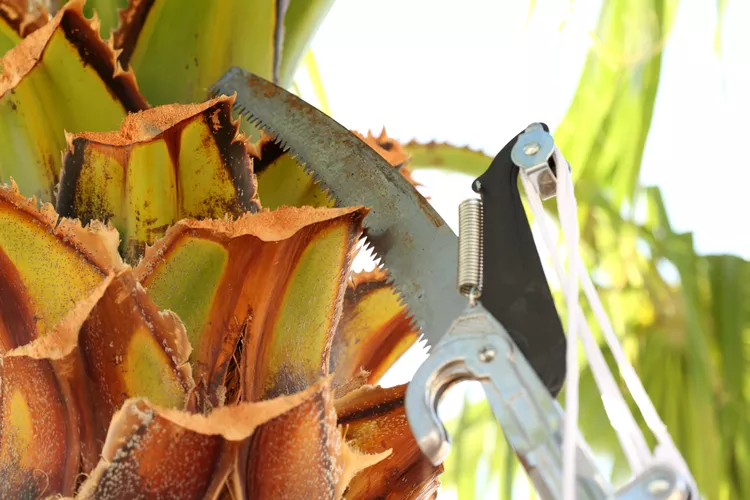Palm trees are iconic symbols of the good life. The mere sight of these swaying tropical plants make you want to hum “Margaritaville” and mix up a rum drink. To keep your palms postcard-perfect, you need to learn the proper palm tree trimming techniques.
Unlike most trees and shrubs, pruning fronds from a palm won’t encourage growth. Palm tree trimming is mostly done for aesthetic purposes. One of the biggest mistakes people make with palm trees is over-pruning them. The following tips from an expert will help you avoid ruining your trees.
Tia Silvasy is an Orlando-based extension agent with the University of Florida.
1. Follow the 9 O’Clock to 3 O’Clock Rule
Only remove fronds that hang below the imaginary horizontal line at 9 o’clock and 3 o’clock positions, Silvasy says. This is a clock face reference, for those of you who aren’t accustomed to analog timepieces. It means don’t prune any fronds that would be within the nine and three on a clock. “A correctly pruned palm is full and has a rounded top that’s shaped like a semi-circle,” Silvasy says. “Don’t cut your palm to look like it has a mohawk.”
2. Do Not Prune Healthy Fronds
Leave healthy green fronds alone. Palms need their leaves to make food via photosynthesis. Palms hold more nutrients in their leaves than other plants, Silvasy says, and they have a unique ability to recycle nutrients. “Palms can suck nutrients out of their lower leaves to feed new leaves at the top of the tree,” she says. Cutting off too many leaves will deprive the tree of nutrition and weaken it, making it vulnerable to winds, insects, and plant diseases.
3. Leave Enough Leaves
Some people believe trimming a lot of fronds from a palm will help it stand up to high winds. Wrong, Silvasy says. “More fronds on a palm help it stand up to wind,” she says. “The University of Florida has done wind studies simulating how palms stand up to 100 mph winds, and we’ve found more leaves protect the palm. They make the tree stronger and better able to bend in the wind.” Palms that are regularly over-pruned can develop narrow, weakened trunks that are more likely to snap in high winds.
4. Remove Dead Fruit and Flower Stalks
Pruning fruit and flower stalks frees up energy for more frond production. And fronds are the reason most of us grow palms. Some people lop off those stalks while they’re still alive and full of fruit because they can make a mess when fruits fall on sidewalks and yards.
5. Only Prune Dead, Dying, or Heavily Damaged Fronds
Cut off fronds damaged in a freeze or broken in a storm. How damaged is heavily damaged? “A general rule of thumb is 50% or more of the palm leaf should be brown before you prune it,” Silvasy says. Prune fronds that have died naturally, too. If a lot of your palm fronds are yellowing, don’t prune them. Fertilize the tree. You may be dealing with a nutrient problem, Silvasy says.
6. Not All Palms Need to be Pruned
Some varieties of these tropical plants are self-cleaning, which means they’ll drop their dead fronds with no help from you. Self-cleaning palms include royal palms, foxtail palms, areca palms, and Christmas palms. Palms that hold onto their fronds after the fronds die include sabal palms, queen palms, and cabbage palms.
7. Use a Pole Saw for Palm Tree Trimming
A pole saw lets you trim fronds without getting on a ladder. Use loppers or a handsaw for shorter palms. Trim fronds close to the trunk. Don’t tear off fronds and don’t cut into the trunk because it can cause wounds that lead to disease.
If you are pruning multiple palms, disinfect your pole saw or pruners with rubbing alcohol or bleach between tree trims to prevent the spread of fungal diseases and pests. You can spread plant diseases from one tree to another with your tools.
8. It’s OK to Leave Dead Fronds on Palms
Some people leave the old, dead fronds on palm trees. Those dead fronds create what’s called a palm beard or palm skirt, and they give the tree a wild, natural look. “It's up to you if you want to prune those dead leaves or not. It’s an aesthetic choice,” Silvasy says. “Leaving dead fronds on a palm will not harm the tree.” Palm beards can help wildlife because those thickets of dead fronds are a popular nesting site for birds.
9. There’s No Wrong Time to Prune a Palm
Palms are pruned primarily for aesthetic reasons so you can trim them any time. Prune dead fronds whenever they appear on the tree. If you live in a hurricane-prone area, prune dead leaves before hurricane season so those dead leaves don’t become missiles in a storm.

